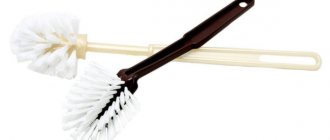To eliminate a sewer blockage, wash fuel oil from clothes, clean a frying pan from burnt fat, you don’t have to use expensive professional chemicals. Use caustic soda - a proven and inexpensive remedy. You will need it when making homemade soap or homemade detergent. When working with caustic soda, follow safety precautions and use protective equipment: rubber gloves and goggles.
Caustic soda has a strong corrosive effect; the second name for caustic soda is caustic soda. The substance is capable of dissolving the most persistent organic contaminants, breaking through and disinfecting sewage drains. Hence its popularity: about 57 million tons of this chemical are consumed annually in the world. Despite the aggressiveness of the product, it is actively used in everyday life. Let's find out in more detail where sodium hydroxide is used and what safety measures need to be taken when working with it.
Basic properties of caustic soda
Due to the fact that it quickly dissolves in water, such an alkali has good properties to absorb vapors from the air. This alkali has a number of characteristic properties:
- soluble in water and alcohol;
- has a high melting point;
- reacts actively with some metals;
- neutralizes fats and other contaminants.
Caustic soda has become widespread precisely because of its main property - degreasing surfaces and neutralizing other contaminants. This ability allows you to get rid of blockages and dirt, which is very helpful when cleaning sewers in private and apartment buildings.
Fighting blockages in sewer pipes
Where is this rubber soda used and how to dilute it at home? Before starting work, you need to make sure that contact with caustic occurs without consequences. Rubber gloves, goggles, and a protective mask are mandatory attributes. Sodium hydroxide has the ability to immediately dissolve fat, no matter how old it is.
If you live in a private house, then to remove blockages you need 3 kg of caustic powder, and in an apartment building 2 kg is enough. You will also need a plastic bucket with thick walls with a volume of 10-12 liters and a convenient scoop or scoop.
The process of preparing the solution itself is as follows. Pour the required amount of alkali into the bucket. Carefully fill with cold water, but not to the very top, but a little more than half (6-7 l), mix well. As soon as the chemical reaction ends, the composition is ready.
We use only cold water for the solution. Caustic, when dissolved, releases heat. Therefore, hot liquid may boil and splash. Cool temperatures will reach a maximum of 70oC.
Solution
Peculiarities. Cast iron and steel can withstand this processing method, but not plastic pipes - caustic can simply corrode the surface of the material. If the blockage is small, it is enough to carry out the procedure once. In advanced cases, manipulations must be repeated after two weeks.
Your actions
- Carefully pour approximately half of the total weight of the resulting caustic solution into the drain hole.
- Make sure that the product does not splash onto the surface of the floor or sink - caustic can corrode the enamel.
- Wait about two to three hours (do not use plumbing).
- Pour in the rest of the solution and wait the same amount of time.
- Turn on the water and pour it into the drain for 10-15 minutes at maximum power.
- If you live in an ordinary high-rise apartment, then the solution does not need to be divided into two doses - fill it all at once. The rest of the manipulations are the same.
"Dry" method
Peculiarities. The method is one of the most effective, but requires maximum care. Suitable for prevention and disinfection, as well as after treatment of sewerage with acidic agents - this way you can neutralize the aggressive effects of acid. Keep in mind that the “dry” cleaning method may damage the pipes.
Your actions
- Pour 2-3 liters of hot water into the drain. This is done to warm the pipes and increase the effectiveness of the procedure.
- Pour two or three tablespoons of powdered or granulated caustic soda (in advanced cases, you can even take one glass) down the drain. Make sure that the substance does not spill onto the surface of sinks, toilets and bathtubs.
- Then pour in hot water (only 200-250 ml is enough).
- Wait two to three hours for the chemical reactions to take place completely.
- Turn the faucet on full blast and rinse off the solution.
Peculiarities. Liquid caustic is less effective in combating blockages, but is safer and more convenient to use. Ideal for preventive purposes. It is enough to repeat cleaning once or twice a month.
Your actions
- Shake the gel thoroughly without opening it.
- Pour about a glass or a little more into the drain (take care of enamel surfaces).
- Follow this with a glass of hot water and wait two to three hours.
- Open the tap to maximum pressure, pour into the drain for 10-15 minutes. This time will be enough for the softened dirt residues to be washed away.
Using caustic soda, you can clean the drains in the bathroom or toilet yourself.
Advice. Caustic soda should not be used for kitchen pipes, since, by reacting with fatty substances accumulated there, it can cause the blockage to thicken.
For cleaning, use sodium hydroxide solution or powder. The second option is safer to use. The powder is poured into the sewer hole, observing all precautions, a glass of warm water is poured into it and left for 2-3 hours. After this time, the pipe is washed.
Another application is to neutralize the effects of acidic agents.
Acids effectively remove any type of grease deposits, which is why they are often used to clean sewer pipes. However, over time they provoke the appearance of metal corrosion. Treatment with caustic soda helps stop this process.
We invite you to familiarize yourself with Wake Up and Mine! How to keep your windows clean for spring
In what areas is rare sodium used?
Due to the fact that caustic soda has a very strong reactivity, it is used in a huge number of industries. For example:
- In the field of chemical production, since caustic soda is a good catalyst;
- In metallurgy;
- Wood processing for paper production;
- Making soap and other products;
- In the textile industry.
It should also be noted that this type of alkali is actively used at home. There are a number of restrictions for using it in everyday life, and all precautions must be taken.
Note! When using it, you should wear goggles and gloves. After use, rinse thoroughly with water, especially if it was used to clean bathtubs, sinks and dishes.
How to work with caustic
The aggressiveness of the substance requires caution in handling it. Caustic soda poses a danger not only to human skin and mucous membranes; inhaled vapors can cause burns to the lungs. Pay special attention to eye protection.
Safety regulations
The first step when working with any household chemicals is to study the instructions for use. In addition to observing the proportions and processing methods, you need to protect yourself from accidental contact of alkali on the skin and mucous membranes.
Store caustic soda in its original packaging, tightly sealed, out of reach of household members.
Before processing, remove children and animals from the premises. Getting started with sodium:
- open the window;
- stock up on vinegar 6 or 9% (it neutralizes caustic matter that accidentally gets on the skin);
- Wear a rubberized apron, safety glasses, and a mask that protects your respiratory system.
When the powder is combined with water, a thermal reaction occurs; take this into account when dissolving a large amount of soda (the dishes must be heat-resistant).
Proportions
When using caustic powder, adhere to the proportions specified in the instructions for use. Having received the desired result of cleaning the item, it will not be damaged. Below we give the ratio of caustic and other ingredients for each specific case.
What to do in case of a caustic burn
Any contact of alkali with skin causes a chemical burn, so it is necessary to take urgent measures to neutralize the substance:
- Place the affected area under running water and rinse for 10–15 minutes.
- Treat the skin with a slightly acidic solution (vinegar, lemon juice).
- Apply a sterile bandage to the burned area.
- Take a pain reliever.
- If the affected area is large, consult a doctor.
If the concentrate gets into your eyes, you need to act urgently, otherwise vision loss will occur due to deep damage to the retina. For this:
- rinse your eyes with cold running water for 15 minutes (with your eyelids apart);
- drip a 2% boric acid solution, rinse again;
- Apply a sterile bandage to your eyes;
- take painkillers;
- until the ambulance arrives, stay in a dark room.
Poisoning by caustic vapors in everyday life is impossible due to the low concentration of the substance.
Use in everyday life
However, in addition to this, caustic soda is quite often used in making soap. Using caustic soda you can solve at least 8 household problems:
- Get rid of scale in the kettle.
- Clean off carbon deposits on dishes.
- Make soap and use it as dishwashing detergent.
- Clear the blockage in the sewer.
- When washing instead of powder.
- As a bleach and stain remover.
- As a floor cleaner.
- Plumbing cleaner.
Caustic soda can be used as a detergent. For example, instead of washing powder. It can also be used for cleaning floors. We will consider recipes for the most common methods of use below.
Safety regulations
- When working with caustic soda, it is recommended to wear safety glasses, rubber gloves and clothing that protects against exposure to chemicals (vinyl-impregnated or rubberized suits).
- The concentration of caustic alkali in the air should not exceed 0.5 mg/m³.
- To protect the respiratory tract, you should use a respirator or a cotton-gauze bandage.
- If sodium hydroxide gets on your skin, hair or mucous membranes, you must provide first aid and consult a doctor.
Despite the second class of danger, caustic soda can be used on the farm (subject to appropriate safety measures).
Pipe cleaning
Using caustic soda to clean drains gives very good results. The alkali will help not only deal with the blockage, but also remove unpleasant odors in the toilet and bathroom. Application methods are as follows:
- Pour half a glass of caustic into the drain hole, carefully pour a glass of boiling water on top and leave for at least two hours. After the specified time, rinse the drains with plenty of water.
- Pour two hundred grams of soda into the hole, add the same amount of white vinegar, leave for three hours, rinse thoroughly with boiling water. This flushing method is used for severe, old clogs.
- Pour two kilograms of caustic into a bucket of boiling water, mix, pour sodium hydroxide and water directly into the drain hole. After three hours, clean the pipes with water.
Important: do not pour soda directly onto the enamel surface of the bathtub, as this may damage the enamel.
Soda can be used when washing; it softens water well and removes various stains. Use caustic soda solution only for washing linen and cotton items; washing silk, wool and other fabrics that require careful handling is not recommended. To prepare the solution in a five-liter container, you need to dilute five tablespoons of soda and mix.
Important: after using caustic soda, things must be rinsed thoroughly.
Carbon deposits and old fat can be removed from steel and cast iron cookware using alkali. You will need the following ingredients:
- Soda - 200 g.
- Water - 10 liters.
- Silicate glue or liquid glass - 150 ml.
- Laundry soap - one bar.
Preparation of the solution: pour water into a container, add soda, glue or liquid glass, grated washing soap, mix everything thoroughly. The dishes are dipped into the washing solution, the container is placed on the fire and boiled over low heat for two hours, after which you need to wait until it cools completely. Rinse the cleaned dishes well under running water.
Important: aluminum and Teflon cannot be washed with caustic soda; calcined salt is used for such dishes. The difference between them is that calcined salt is much less active and will not damage the dishes.
Cleaning the cesspool
Peculiarities. Getting caustic into the soil has a negative effect on the soil. Therefore, the pit must be absolutely sealed and have a proper ventilation system.
Your actions
- Prepare the solution according to the same principle as described above for sewer pipes. Depending on the size of the pit, 2-4 kg of caustic soda will be required.
- Fill the drainage hole with the mixture.
- As a rule, the active period of the product lasts about four minutes.
- The cycle must be repeated twice.
Caustic soda is classified as a gentle substance for cleaning cesspools, but its use is possible only if all conditions are met:
- Septic tanks must be sealed, since the substance, when reacting, can harm the soil and the environment.
- To avoid an explosive situation, the ventilation system must operate without interruption.
- You cannot start cleaning without a protective suit, gloves, and goggles.
Sewage pits are cleaned using a caustic alkali solution.
The portion of soda indicated in the instructions is diluted in cold water, stirring constantly. At the peak of its activity, the composition lasts for about four minutes, so the product is immediately used for its intended purpose.
Soot and scale
You can often see sodium hydroxide recommended as an effective home remedy for cleaning dishes from scale and deposits.
Caustic soda can really cope with these problems due to its ability to easily remove even old plaque.
Approximately half a glass of caustic alkali is diluted in a bowl of cold water, the dishes are immersed there and left for 5-15 minutes, depending on the degree of contamination. If necessary, repeat the procedure.
Modern cleaning products cope with soot and scale no worse than caustic sodium, but do not require careful adherence to personal safety rules.
Therefore, it is advisable to use caustic soda only when other methods have proven ineffective.
Where to buy and how much it costs
You can buy the chemical at a hardware store or hypermarket, in the department that sells household chemicals. Its price may vary depending on the manufacturer and weight. At retail, 250 g of caustic soda costs around 200 rubles.
Caustic soda can be purchased at hardware stores. Sometimes it is found in departments specializing in the sale of goods for soap makers. It can also be found on the Internet: on sites specializing in the supply of caustic soda. The price per kilogram usually does not exceed 100 rubles.
Sodium hydroxide is often included in multi-component products designed to clean dishes, cesspools and sewer pipes. You can find them in departments offering household chemicals. Such products are intended for home use and are therefore relatively safe. In addition, their effectiveness is higher than that of conventional caustic alkali due to the inclusion of additional ingredients.
Caustic soda can cope with complex stains on dishes and facilitate the process of cleaning sewers and waste pits, but it can only be used if precautions are carefully observed.
If this substance gets on the mucous membranes or skin in the absence of timely help, it can have irreversible consequences. Therefore, for home use it is better to choose safer options.
Caustic soda is a widely used product, so you can buy caustic soda in various specialized stores:
- in hardware stores - detergent departments;
- gardening stores;
- construction markets;
- soap shops.
The product is also sold on online platforms. Approximate cost up to 100 rubles. per kilogram.
When using caustic alkali in everyday life, take precautions, then soda will turn from a dangerous substance into an effective assistant for cleaning and disinfecting your home and garden.
Sodium hydroxide is available at building supply and plumbing supply stores.











